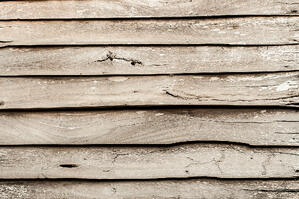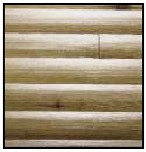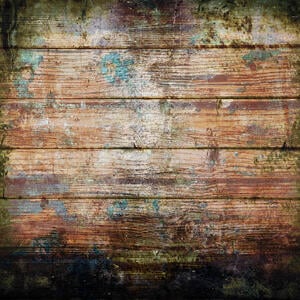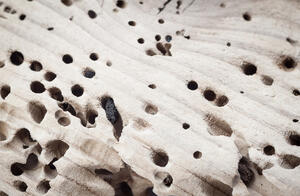what happens to a project if it has too high of a moisture content
However, what happens when moisture meters aren't used in the manufacture of woods products? Without the use of a reliable moisture meter, finding pockets of moisture in wood is reduced to a woefully inaccurate process of "eyeballing it" that volition miss moisture problems that could be hiding within a piece of lumber, even something as thin as a plank. Woods needs to exist in the appropriate equilibrium moisture content (EMC) determined by the year-round conditions information technology volition be exposed to before existence shipped out. If the wood does not reach the right EMC, numerous problems may occur, such equally: What happens to wood that is stored in an environment with a significantly higher wet content than the site of its terminal installation? Wood is a hygroscopic material, meaning that is prone to absorbing wet: however, the contrary is likewise true. Woods can lose moisture in a dry environs but as easily every bit it absorbs moisture in a boiling 1. When forest that is stored in a place with loftier backlog moisture is moved to a location that is devoid of wet, it loses some of its backlog moisture to the air of the new environment. This, in turn, can crusade the wood to tuck over time. Dehydrated wood loses its shape and tin become unsightly. The severity of this effect will vary depending on the specific species of wood used, what it is used for, and just how much of a discrepancy there is between the conditions that the woods was acclimated to and the conditions in which the wood is being used. In woods floor planks, swelling from excess moisture can cause cupping, crowning, and buckling, even in engineered hardwood.For article of furniture, swollen forest tin can be a astringent problem, equally it can make assembly of the wood more difficult, and the terminal production unstable. Joints where multiple pieces of wood that are swollen connect can become broken by the pressure acquired by the swelling, essentially breaking that piece of article of furniture. Also known every bit buckling, this is 1 of the more than obvious and extreme forms of damage to wood flooring. This problem is identified past the complete separation of a section of floor from the subsurface fabric. There can be a number of reasons why this happens, from improper sealing of the wood planks to the adhesive beneath, to a lack of sufficient nails, or to astringent flaws in the subfloor itself (such every bit too much moisture). When moisture is the root of the problem, in that location may be other problems as well past the fourth dimension the impairment is astringent enough to crusade the planks to start separating from the floor. Excessive mold spores coming off of a piece of wood can result in minor to astringent respiratory infections, so preventing the growth of mold colonies in the first place is a very important task. By inspecting woods thoroughly with a moisture meter, woodworkers can make sure that there is no hidden moisture in their wood just waiting to go mold colonies. As wood swells or shrinks from changes to its moisture content, the changes in its size and shape acquired by this phenomena can distort the joints in an object made of wood. Joints where multiple pieces of wood are connected may weaken every bit the wood pushes confronting or pulls away from the joint, loosening fastenings and weakening that joint. Weakened joints are more susceptible to catastrophic failure when exposed to sudden force. For instance, a chair that has loosened joints may break if someone jumps on it, or the frame of a house might plummet under hurricane-forcefulness winds. It is rare that the swelling of large objects such as a wooden support beam are so affected by wet, but information technology is a concern nevertheless. Improperly-dried wood can stink to loftier heaven. Every bit mold spores spread and the wood rots, the musty olfactory property given off past that slice of forest tin get overpowering. This problem might non sound as astringent every bit some of the others on this list, but it tin ruin a woodworker's reputation. Afterwards all, nobody likes their firm and furniture to odor bad. Thankfully, this trouble is rare because woodworkers use moisture meters to spot excessive wet in wood before working with it. Go the Chore Washed Right with a Wet Meter Of course, the old maxim that "an ounce of prevention is worth a pound of cure" holds true for all of these wet-related bug. Using a moisture meter to detect a potential problem earlier it becomes an accented catastrophe can save you lot money, time, and headaches downward the road. Don't gamble with the seven woodworking nightmares; be certain of your work with a reliable, summit of the line wet meter from Delmhorst today.  Professional woodworkers know that there are many risks fastened to assuasive moisture in wood to become unchecked for too long. In gild to monitor their specific moisture-related risks in woods, these professionals use a number of wet meters, such equally pin-type and pinless meters to find wet in wood. With the assistance of these devices, woodworkers tin can verify that the forest they're working with is properly stale before sending out their products, whether they're drying lumber, making woods floor, furniture, or structural supports for a house.
Professional woodworkers know that there are many risks fastened to assuasive moisture in wood to become unchecked for too long. In gild to monitor their specific moisture-related risks in woods, these professionals use a number of wet meters, such equally pin-type and pinless meters to find wet in wood. With the assistance of these devices, woodworkers tin can verify that the forest they're working with is properly stale before sending out their products, whether they're drying lumber, making woods floor, furniture, or structural supports for a house. ane) Shrunken Woods Planks
2) Swollen Wood Planks
 The opposite of the previous problem occurs when wood starts to absorb backlog h2o. Plank flooring, boards, beams, etc. that have likewise much moisture in them are susceptible to a host of issues, non the least of which is the concrete swelling of the wood.
The opposite of the previous problem occurs when wood starts to absorb backlog h2o. Plank flooring, boards, beams, etc. that have likewise much moisture in them are susceptible to a host of issues, non the least of which is the concrete swelling of the wood. 3) Delamination
4) Mold Growth
 This is i of the more than insidious hazards related to excess wet in wood. Not only tin mold compromise the strength and integrity of wood, information technology can pose a severe wellness risk to people who are exposed to it, particularly to those with compromised immune systems or allergies.
This is i of the more than insidious hazards related to excess wet in wood. Not only tin mold compromise the strength and integrity of wood, information technology can pose a severe wellness risk to people who are exposed to it, particularly to those with compromised immune systems or allergies. 5) Weakness in Load-Bearing Woods Items
6) Insect Infestations
 Moisture-rich wood is a key source of nutrition for many mutual pests, such as ants or termites. A large pocket of moisture attracts pests to that piece of wood, which incurs a host of bug. Given enough time, these infestations can spread to the remainder of the edifice, causing more than issues. Few things volition upset a client as quickly as finding out that their brand new couch is total of stinging, bitter insects.
Moisture-rich wood is a key source of nutrition for many mutual pests, such as ants or termites. A large pocket of moisture attracts pests to that piece of wood, which incurs a host of bug. Given enough time, these infestations can spread to the remainder of the edifice, causing more than issues. Few things volition upset a client as quickly as finding out that their brand new couch is total of stinging, bitter insects. 7) Bad Smell

Source: https://www.delmhorst.com/blog/woodworking-nightmares
0 Response to "what happens to a project if it has too high of a moisture content"
Postar um comentário